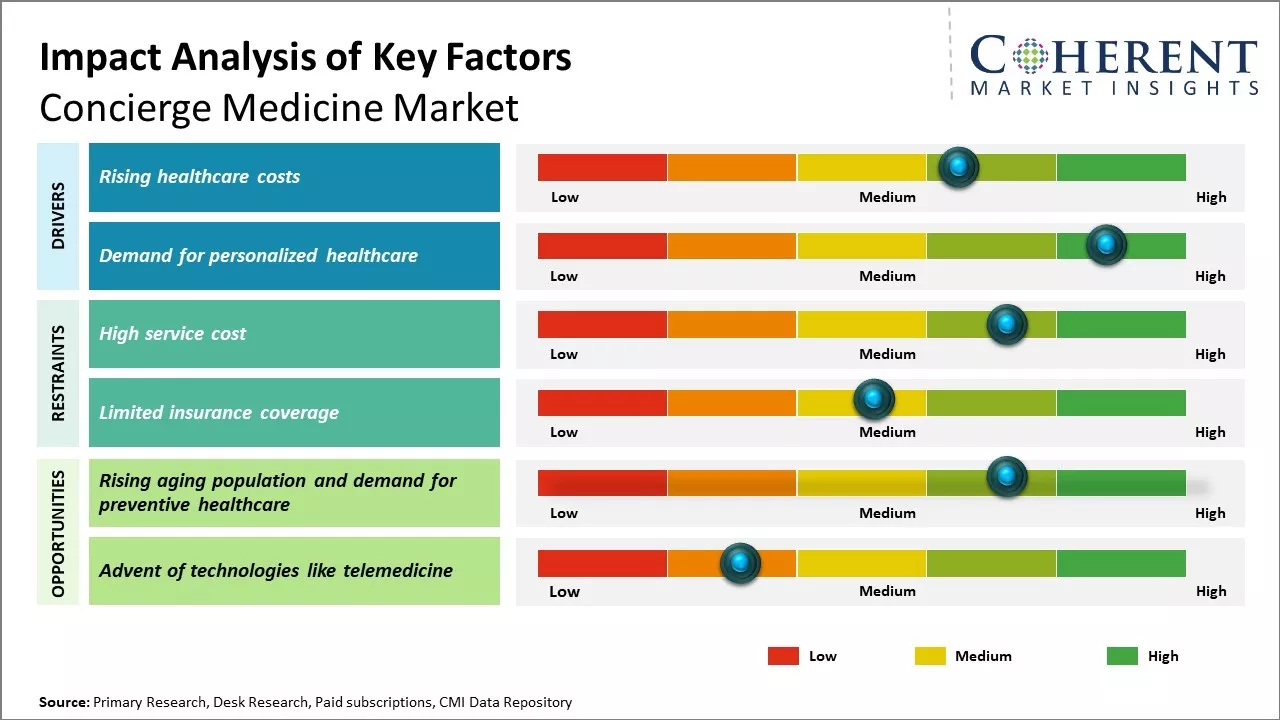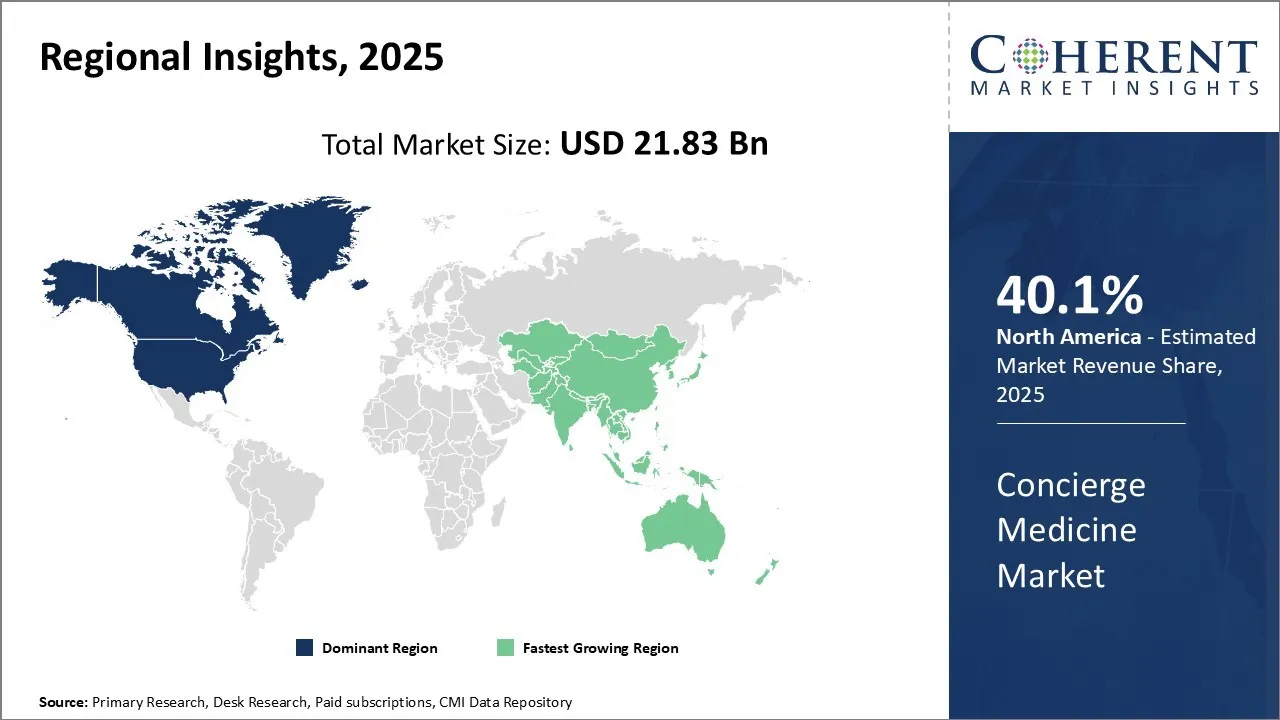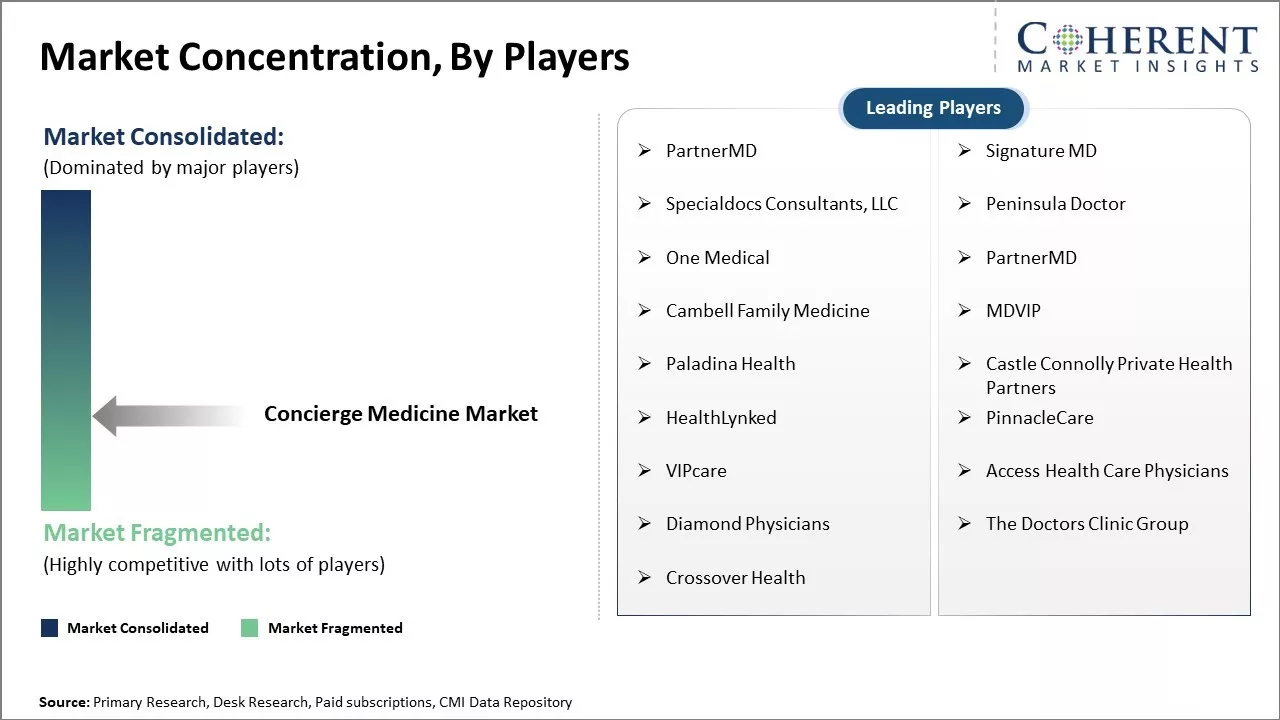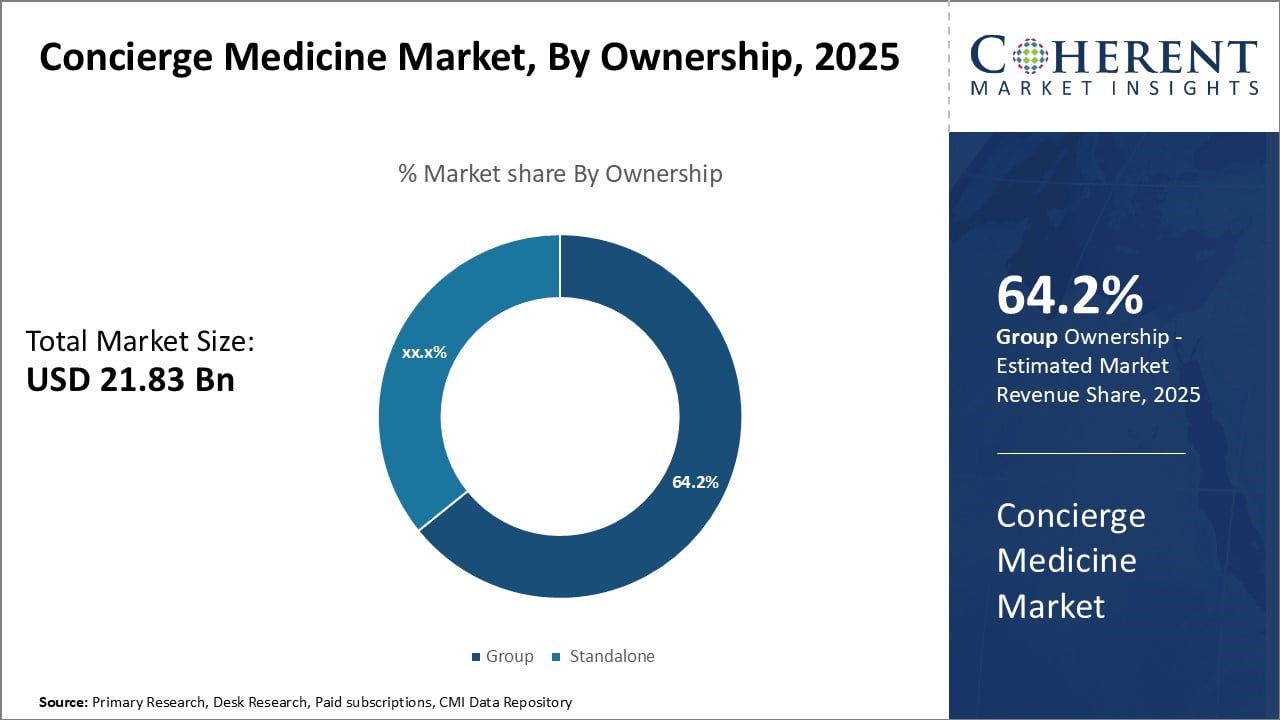Concierge Medicine Market Size and Trends – 2025 to 2032
The concierge medicine market is estimated to be valued at USD 21.83 Bn in 2025 and is expected to reach USD 42.29 Bn by 2032, exhibiting a compound annual growth rate (CAGR) of 9.9% from 2025 to 2032.

To learn more about this report, Download Free Sample
Key Takeaways
- Based on Ownership, Group practices are projected to dominate the market, accounting for approximately 64.2% of the share in 2025. This is attributed to their ability to offer enhanced services and amenities through economies of scale.
- Based on Application, Primary care is expected to hold a significant portion of the market, with an estimated share of 38.6% in 2025. The emphasis on preventive healthcare and chronic disease management contributes to this dominance.
- Based on End User, the individuals’ segment is anticipated to lead, capturing about 42.4% of the market share in 2025. This trend is driven by the growing demand for personalized healthcare services among consumers.
- Based on Region, North America is set to retain its market dominance, holding a share of 40.1% in 2025. Factors such as a favorable regulatory environment, high disposable incomes, and a well-established healthcare infrastructure contribute to this leadership.
Market Overview
Concierge medicine has witnessed increased adoption in recent years. The model enables physicians to spend more quality time with fewer patients, offering enhanced experience. It is a lucrative option for physicians seeking an improved work-life balance as well. As out-of-pocket healthcare costs continue rising, more customers are drawn to the cost-effective yearly retains and same-day appointments associated with concierge medicine. Overall, the demand for enhanced healthcare services drives the concierge medicine market growth.
Current Events and Its Impact
|
Current Events |
Description and its impact |
|
Global Economic Slowdown & Inflationary Pressures |
|
|
North American Regulatory Environment Evolution |
|
|
Geopolitical Events and Regional Conflicts |
|
Uncover macros and micros vetted on 75+ parameters: Get instant access to report
Concierge Medicine Market: End User Feedback and Unmet Needs
- End User Feedback
- Positive Feedback:
- Personalized Care: Patients appreciate the high level of personalized attention, longer appointments, and continuity of care.
- Access & Convenience: Patients value direct access to physicians via phone, email, or text, as well as same-day or next-day appointments.
- Preventive Focus: Many users find the proactive, preventive care approach improves overall health outcomes.
- Reduced Wait Times: The absence of crowded waiting rooms and reduced scheduling delays are highly praised.
- Comprehensive Health Management: Patients like integrated management of chronic conditions and holistic wellness advice.
- Negative Feedback / Challenges:
- Cost Barrier: The high annual fees (often USD 1,500 to USD 5,000+) limit accessibility for many potential patients.
- Insurance Issues: Concierge services are often not covered by insurance, creating confusion and limiting broader adoption.
- Variability in Services: Differences in offerings between concierge practices sometimes lead to inconsistent patient expectations.
- Limited Specialist Access: Some patients report challenges coordinating specialist referrals or receiving coverage for specialist care.
- Technology Gaps: A few users feel the digital tools for telehealth or communication can be improved for smoother interactions.
- Unmet Needs
- Affordability and Flexible Payment Options:
- Many potential users want more tiered pricing or partial insurance coverage to make concierge medicine more affordable.
- Demand for models that blend traditional insurance with concierge services (hybrid plans).
- Broader Specialist Network Integration:
- Enhanced coordination and partnerships with specialists to provide seamless referrals and integrated care.
- Improved communication channels between concierge physicians and specialists.
- Improved Technology Platforms:
- More robust, user-friendly telemedicine and patient portal systems.
- Tools that allow real-time health monitoring, AI-driven insights, and better data sharing.
Concierge Medicine Market Insights, By Ownership - Group ownership facilitates expansion to new geographies
In 2025, group-owned concierge practices are expected to hold 64.2% of the concierge market share. Group models offer key advantages: shared resources, centralized billing and HR, and standardized care protocols lower per-patient costs and improve efficiency. Concierge Choice Physicians (CCP) shows how large medical groups can embed concierge services into their operations, creating consistency across multiple locations. Specialdocs Consultants has grown nationally by helping independent doctors adopt the concierge model under a unified network, supporting rapid geographic expansion. Group ownership also provides negotiating power for bulk purchases and facilitates brand-driven patient trust, which increases cross-referrals. As a result, group practices are better positioned to scale, expand, and maintain consistent quality, driving their dominance in the concierge medicine market growth.
Concierge Medicine Market Insights, By Application - Comprehensive Services Fuel Primary Care Dominance
The application segment of the concierge medicine market includes cardiology, primary care, psychiatry, pediatrics, osteopathy, neurology, and others. Among these, primary care is expected to command a 38.6% concierge medicine market share in 2025. As the first point of contact, primary care plays a central role in preventive healthcare, minor ailment treatment, and chronic condition management—making it especially compatible with the personalized, accessible nature of concierge medicine. It supports a broad spectrum of general health needs across pediatrics, geriatrics, women's health, and long-term disease management. A key strength of concierge primary care is the enduring doctor-patient relationship, which fosters trust and allows providers to address behavioral and lifestyle factors that influence long-term health outcomes. This holistic care model leads to stronger patient loyalty compared to specialist-driven care.
For example, a Time article explores how concierge primary care providers spend more time with patients, enabling deeper conversations and proactive management of health—elements often missing in conventional care settings. Similarly, CBS News highlights that patient in concierge primary care benefit from direct physician access, quick appointments, and a focus on prevention, all of which improve care quality and satisfaction. This is further escalating the concierge medicine market demand.
Concierge Medicine Market Insights, By End User - Growing demand for customized care plans drives individual segments growth
The end user segment in the concierge medicine market includes individuals, corporate organizations, and government agencies. The individuals subsegment is projected to hold 42.4% of the Concierge Medicine market share in 2025, driven by the rising demand for personalized, insurance-free healthcare. Concierge practices cater directly to self-paying clients, enabling longer consultations, preventive care, and customized health plans based on lifestyle and genetics. Patients benefit from direct physician access, faster appointments, and the convenience of online records—without insurance delays. As noted by the New York post, individuals are increasingly willing to invest in these premium services for peace of mind and continuity of care. Verywell health further highlights that concierge medicine meets the need for a “human touch,” with patients valuing long-term relationships and physician advocacy.
Regional Insights

To learn more about this report, Download Free Sample
North America Concierge Medicine Market Trends
North America has long dominated the global concierge medicine market and is expected to hold 40.1% of the market share in 2025. The United States—where concierge medicine began gaining traction in the early 2000s—benefits from a favorable regulatory environment, widespread private insurance coverage, and a large affluent population willing to pay for premium, personalized care. Metropolitan centers such as New York, Los Angeles, Chicago, and Boston host well-established concierge networks that cater to high-income individuals seeking VIP-style medical services.
In October 2024, Cleveland Clinic revealed to broaden healthcare services in Nevada by launching concierge medicine and executive health practices, which are scheduled to start seeing patients in the third quarter of 2025 and throughout 2026.
Asia Pacific Concierge Medicine Market Trends
Asia Pacific is emerging as the fastest-growing region in the global concierge medicine market, driven by rising middle- and upper-income populations, growing health awareness, and frustration with overburdened public healthcare systems. Countries like China, Japan, South Korea, and Singapore are seeing increasing adoption of personalized care models. A strong example is AXA Hong Kong’s partnership with EC Healthcare in May 2025 to launch an Endoscopy Concierge and Day Surgery Centre, offering streamlined, no-preauthorization services. This reflects growing patient demand for convenience, access, and premium care—trends expected to fuel continued concierge medicine market growth across the region.
United Kingdom Concierge Medicine Market Trends
In the United Kingdom, concierge medicine is gaining traction as patients seek alternatives to the National Health Service (NHS) due to long wait times and limited appointment availability. Private healthcare providers are expanding their concierge offerings, providing services such as same-day appointments, extended consultations, and personalized health plans. The concierge medicine market growth is supported by a segment of the population willing to pay for enhanced access and continuity of care. The adoption of concierge medicine in the UK is also influenced by the increasing demand for preventive care and wellness services. Concierge Choice Physicians (CCP), a leading provider of hybrid concierge medicine programs in the U.S., announced today the launch of Concierge Choice UK (CCUK), the first personalized, choice-driven concierge medicine program in the United Kingdom.
India Concierge Medicine Market Trends
India concierge medicine market is gaining momentum, fueled by rising demand for personalized care and digital health innovation. Bajaj Finserv Health launched its ‘Health Saathi’ concierge service, backed by a ₹1,000 crore investment to streamline hospital navigation, documentation, and treatment coordination—especially for mobile professionals. Similarly, WhiteGlove, an AI-powered medical concierge platform, now helps U.S.-based individuals manage healthcare for their families in India, offering 24/7 care coordination, digital records, and medication reminders. These developments reflect India’s growing embrace of concierge care to address both domestic and cross-border health needs. This is further positively influencing the concierge medicine market forecast.
Market Concentration and Competitive Landscape

To learn more about this report, Download Free Sample
Concierge Medicine Industry News
- In March 2024, Sollis Health, a concierge care provider, and Prenuvo, the company pioneering proactive whole-body magnetic resonance imaging for early cancer detection and other diseases, announced their partnership to offer new Sollis Health members an opportunity for early detection and coordinated care for conditions like cancer, aneurysms, and other diseases.
- In May 2023, eClinicalWorks, the largest ambulatory cloud Electronic Health Record, announced that New Life Health & Concierge, a primary care practice specializing in patient-centered concierge medicine, selected eClinicalWorks and healow (a smartphone application) to improve efficiency, drive patient acquisition, enhance patient engagement, and lower costs.
- In March 2023, CourMed, a leading provider of concierge health services, announced the launch of its personal membership service for concierge health and wellness visits. This new service is designed to bring personalized care to busy professionals in the comfort of their own homes, offices, condos, or while on the go.
- In March 2023, HealthLynked, a leading provider of digital healthcare solutions, announced the launch of its new Online Concierge service for physician appointment bookings. Patients can now book appointments with any healthcare provider across the country through the HealthLynked Network's online medical directory of over 880,000 healthcare providers and practice locations.
Market Report Scope
Concierge Medicine Market Report Coverage
| Report Coverage | Details | ||
|---|---|---|---|
| Base Year: | 2024 | Market Size in 2025: | USD 21.83 Bn |
| Historical Data for: | 2020 To 2024 | Forecast Period: | 2025 To 2032 |
| Forecast Period 2025 to 2032 CAGR: | 9.9% | 2032 Value Projection: | USD 42.29 Bn |
| Geographies covered: |
|
||
| Segments covered: |
|
||
| Companies covered: |
PartnerMD, Signature MD, Specialdocs Consultants, LLC, Peninsula Doctor, One Medical, PartnerMD, Cambell Family Medicine, MDVIP, Paladina Health, Castle Connolly Private Health Partners, HealthLynked, PinnacleCare, VIPcare, Access Health Care Physicians, Diamond Physicians, The Doctors Clinic Group, and Crossover Health |
||
| Growth Drivers: |
|
||
| Restraints & Challenges: |
|
||
Uncover macros and micros vetted on 75+ parameters: Get instant access to report
Concierge Medicine Market Trends
Rising healthcare costs
The healthcare costs in the U.S. have been increasing at an unsustainable rate for many years. People and organizations are constantly looking for ways to reduce these costs and make healthcare more affordable and accessible. Concierge medicine addresses this driver by offering an alternative model of primary care. Through annual membership fees, concierge practices are able to dramatically reduce patient loads allowing doctors to spend more quality time with each patient. This personalized attention helps identify health issues early before they develop into expensive, complex conditions. It focuses on preventive measures and lifestyle changes that can avoid hospitalizations and expensive specialist visits down the road. Concierge doctors also have greater flexibility to coordinate and facilitate specialty referrals and tests. This coordination of care helps streamline the process and reduces unnecessary duplicate tests, thereby lowering overall healthcare spending. As healthcare costs continue to rise significantly each year, more individuals and employers will find the promise of reduced costs through concierge practices appealing over traditional insurance plans.
Market Concentration and Competitive Landscape
Demand for personalized healthcare
In today's fast paced world, people often feel that traditional healthcare lacks personal attention. Most doctors are overloaded with large patient loads and only have 10-15 minutes for each appointment. This limited time does not allow doctors to truly understand a patient's complete medical history, lifestyle, and concerns. It makes it difficult for any meaningful discussion beyond addressing the immediate issue. However, people increasingly want healthcare that offers convenience, availability, and personalized attention to their individual needs. This is where concierge medicine fulfills an important need. Through reduced patient loads, concierge doctors are able to spend 30-60 minutes with each patient. They can develop strong relationships and truly get to know the patients, their families and their life circumstances. Doctors proactively reach out when patients are due vaccines or screenings. They welcome 24/7 access through phone, email or telehealth. Patients feel more involved in their own care through meaningful discussions to establish prevention plans. This level of personalized care leads to better health outcomes and a more positive healthcare experience compared to traditional, assembly-line medicine. As such models closely align with consumer demands, more people will opt for concierge practices.
Concierge Medicine Market Opportunities – Rising aging population and demand for preventive healthcare
An aging population and greater focus on preventative healthcare is increasing the demand for more access and attention from physicians. As out of pocket healthcare costs continue rising, consumers are increasingly willing to pay extra for a higher level of service and care coordination. Concierge practices also gain new patients through word of mouth as those who enroll spread awareness of their beneficial experiences.
Market Segmentation
- Ownership Insights (Revenue, USD BN, 2020 - 2032)
- Group
- Standalone
- Application Insights (Revenue, USD BN, 2020 - 2032)
- Cardiology
- Primary Care
- Psychiatry
- Pediatrics
- Osteopathy
- Neurology
- Others
- End User Insights (Revenue, USD BN, 2020 - 2032)
- Individuals
- Corporate Organizations
- Government Agencies
- Regional Insights (Revenue, USD BN, 2020 - 2032)
- North America
- U.S.
- Canada
- Latin America
- Brazil
- Argentina
- Mexico
- Rest of Latin America
- Europe
- Germany
- U.K.
- Spain
- France
- Italy
- Russia
- Rest of Europe
- Asia Pacific
- China
- India
- Japan
- Australia
- South Korea
- ASEAN
- Rest of Asia Pacific
- Middle East
- GCC Countries
- Israel
- Rest of Middle East
- Africa
- South Africa
- North Africa
- Central Africa
- Key Players Insights
- PartnerMD
- Signature MD
- Specialdocs Consultants, LLC
- Peninsula Doctor
- One Medical
- PartnerMD
- Cambell Family Medicine
- MDVIP
- Paladina Health
- Castle Connolly Private Health Partners
- HealthLynked
- PinnacleCare
- VIPcare
- Access Health Care Physicians
- Diamond Physicians
- The Doctors Clinic Group
- Crossover Health
Sources
Primary Research Interviews from the following stakeholders
Stakeholders
- Interviews with concierge physicians, healthcare administrators, direct primary care providers, healthcare consultants, and industry experts specializing in personalized and membership-based care delivery models.
- Specific stakeholders Internal medicine specialists, family medicine practitioners, healthcare policy experts, practice managers, and patient care coordinators.
Databases
- PubMed
- ClinicalTrials.gov
- HealthData.gov
- CMS Data Navigator
- National Library of Medicine
Magazines
- MedTech Insight
- Healthcare Technology News
- Concierge Medicine Today
- Medical Economics
- HealthTech Magazine
Journals
- Journal of General Internal Medicine
- American Journal of Managed Care
- Journal of Health Economics
- Journal of Primary Care & Community Health
- Journal of Medical Practice Management
Newspapers
- The New York Times
- The Guardian
- The Wall Street Journal
- Financial Times
- The Washington Post
Associations
- American Academy of Private Physicians (AAPP)
- American Medical Association (AMA)
- American College of Physicians (ACP)
- American Telemedicine Association (ATA)
- Healthcare Financial Management Association (HFMA)
Public Domain Sources
- World Health Organization (WHO)
- Centers for Disease Control and Prevention (CDC)
- Food and Drug Administration (FDA)
- National Institutes of Health (NIH)
- U.S. Department of Health and Human Services (HHS)
Proprietary Elements
- CMI Data Analytics Tool, and Proprietary CMI Existing Repository of information for last 8 years
*Definition: The concierge medicine market refers to healthcare practices that offer patients direct primary care services for an annual or monthly subscription fee. Such practices cater to an exclusive membership of patients by providing amenities like same-day appointments, extended consultation hours, home visits, and electronic access to doctors. Concierge physicians have a limited number of patients to allow for personalized attention and preventive care approach beyond typical primary care. This unique model aims to offer patients a higher quality of personalized medical services for a direct financial commitment.
Share
Share
About Author
Vipul Patil is a dynamic management consultant with 6 years of dedicated experience in the pharmaceutical industry. Known for his analytical acumen and strategic insight, Vipul has successfully partnered with pharmaceutical companies to enhance operational efficiency, cross broader expansion, and navigate the complexities of distribution in markets with high revenue potential.
Missing comfort of reading report in your local language? Find your preferred language :
Transform your Strategy with Exclusive Trending Reports :
Frequently Asked Questions
EXISTING CLIENTELE
Joining thousands of companies around the world committed to making the Excellent Business Solutions.
View All Our Clients

